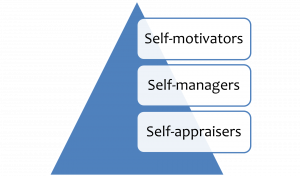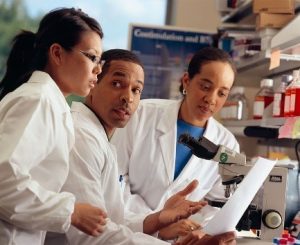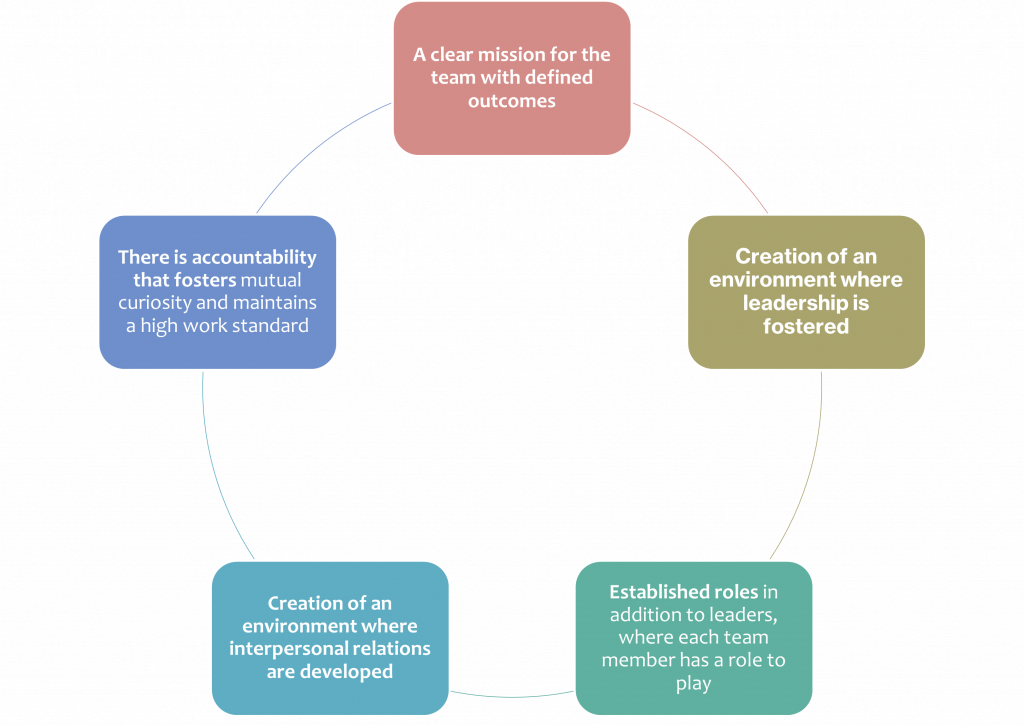9 Your Life and Career as a Scientist
So far, you learned ‘how to do science’. But what now? Being a scientist means that science will be a part of your life for years to come.
The way a scientist thinks and behaves informs how they carry out scientific tasks. Alongside developing your scientific knowledge and skills throughout your science degree, you will be given the opportunity to develop the personal and professional responsibility that will guide you throughout your life – professionally and personally.
This chapter explains what it means to be a scientist, which is more than just ‘doing science’. You’ll also learn about careers options, and how to use your skills once you enter the workforce.
A group of science academics, science students, employment groups and professional societies. identified three things that a science graduate should know and be able to do regarding accountability for their own learning and scientific work by the time they graduate (Yucel, 2013). This includes:
- Being independent and self-directed learners
- Working effectively, responsibly and safely as an individual or a team
- Demonstrating knowledge of the guidelines and laws relevant to their disciplinary areas, and personally practising ethical conduct
9.1 Being independent and self-directed learners

Employers of science graduates often try to find candidates with a variety of skills such as having the ability to make decisions, being project management-minded, being resourceful and having good problem-solving abilities (Yucel, 2013).
In the workforce, science graduates often find themselves in an environment that has little direction from management, and they may need to develop or adapt new skills and understandings. Therefore, as a student scientist, learn to take responsibility for your success during your studies, so you will be prepared to continue doing so after you graduate.
To succeed in your chosen career, you will need to develop autonomy as a learner and be able to judge your own performance – Figure 9.1 shows the characteristics you will need to become an independent and self-directed learner.
Cognitive skills you need to be a good scientist
To be able to think like a scientist and conduct all of the tasks required of a scientist, you need to develop the cognitive skills lying along a continuum – from simple to complex – as shown in Bloom’s taxonomy of learning (Figure 9.2).

Capabilities and attributes required to be a scientist
Capabilities and attributes are skills that you can demonstrate and are highly valued by employers.
Most universities have a set of skills that are referred to as ‘graduate capabilities’ and these are usually focused around similar skillsets. Sometimes graduate capabilities are referred to as ‘generic skills’ or ‘transferable skills’ – but most of all they can be thought of as ‘interdisciplinary skills’ that are important in science as well as a range of other disciplines.
Interdisciplinary skills are the foundation skills that graduates will use in their everyday work to communicate effectively, professionally, ethically, and with understanding for the diversity of the population in all occupations and disciplines (La Trobe University, 2016).
9.2 Working effectively, responsibly and safely as an individual or a team
Scientists will work both independently and in teams, and will practise working in both contexts during their undergraduate degree – see below (Whatley, 2009).
As a student scientist, it is essential that you adopt a professional approach to your scientific learning and work because this will ultimately help you to make important contributions to science and society.
Ways in which you can adopt a professional approach include:
- demonstrate the use of appropriate techniques and equipment in projects
- be organised, on time and respectful to colleagues
- demonstrate an awareness of relevant issues such as environmental, safety, community or political issues
- seek a range of information to develop and strengthen projects that you are part of
- interact with appropriate specialists to achieve agreed outcomes and develop broader knowledge
- adapt positively to change and take initiative
- complete tasks in a safe, competent and timely manner
- demonstrate professional ethics

Student scientists should conduct scientific enquiry in a manner that falls within the codes of practice for workplace health and safety. This includes considering the following when relevant:
- basic workplace health and safety
- biological safety
- chemical safety
- electrical safety
- laboratory equipment safety
- personal protective equipment
- radiation and laser safety
Team context
All scientists work in teams, and student scientists will get to practise their team work skills during their undergraduate degree. Some features of successful teams are shown in Figure 9.4.

Teams are formed when people come together to work towards a common goal
Resource
Read about how you can be an effective and efficient team member in this Good Practice Guide [PDF].
Team projects
There are several things you should consider when starting a team project:
- Get to know the rest of your team. Think of your team as puzzle pieces that can be placed together in a variety of ways (Llopis, 2012).
- Establish team work agreements. Newly established teams should consider completing a team work agreement. It has been shown that team cohesion, trust, and awareness of members’ obligations, expectations of others and working relationships are improved when teams establish ground rules at the beginning of a project (Whatley, 2009).
- Create team goals. Decide on the big-picture goals of the team and record these (perhaps in your team agreement).
- Create task lists, and clearly define roles and responsibilities. A team should operate as a mosaic whose unique strengths and differences convert into a powerful united force (Llopis, 2012). Create a detailed task list and a time line for completion of these tasks.
- Decide on a team communication process. This includes the preferred method, frequency and nature of team communication, and ensure relevant contact details are shared. Consider making use of tools that let you communicate and collaborate with your team mates online. For example, use Zoom software for online video meetings when you can’t meet in person. Office365 and Google software allow multiple people to work together on one document, spreadsheet or presentation.
- Establish proper team dynamics. Decide on acceptable and unacceptable team dynamics, and record how unacceptable team dynamics will be dealt with should they arise (perhaps in your team agreement).
Box 9.1: Effective ways to communicate with your team
Here some effective ways to communicate with your team – compiled from past student scientists.
- Share phone numbers and email addresses
- Reply to team members in a timely fashion
- Arrive at team meetings and class on time
- Use social media to communicate
- Complete necessary and appropriate prereading
- Set small, achievable deadlines frequently
- Have a team brief at the beginning of team sessions
- Use time wisely
9.3 Guidelines, laws and ethical conduct
High-quality science graduates have an understanding of their social, cultural and environmental responsibilities as they study the natural world.
As a student scientist, you should do your best to behave ethically throughout your undergraduate study, to prepare you to become an ethical professional. Examples of ethical conduct in action include:
- accurate data recording and storage
- proper referencing and avoiding plagiarism
- intellectual integrity
- safely disposing of biological and chemical waste
- knowledge and application of the principles of animal ethics and/or human ethics.
Being an ethical scientist is more than just doing the right thing. It requires scientists to act in the right spirit, out of respect and concern for one’s fellow creatures (National Health and Medical Research Council et al., 2015).
How to be an ethical scientist – personal responsibility
Scientists and philosophers have spent their lives considering the aims of science and how scientific research should be conducted. Haque et al. summarised the most important principles displayed by an ethical scientist (Hasque et al., 2022).
How to be an ethical scientist – guidelines and laws
In many cases, the government may be involved in establishing guidelines or laws for safe and ethical behaviour.
Guidelines are sets of non-mandatory rules, principles or recommendations for procedures or practices in a particular field. Laws are rules that regulate the actions of people and may be enforced by applying penalties.
There are guidelines and laws relevant to scientists that cover experimentation and data collection, quality control procedures and appropriate safety procedures. There are also instances when you might need to obtain a government permit for a certain type of activity or research. For example, scientists and student scientists need to perform scientific work in accordance with the Workplace Health and Safety Act 2011. This act provides a balanced and nationally consistent structure to help protect workers, including science students, against harm to their health, safety and welfare by eliminating or minimising work-related risks.
Human research
Scientists and science students involved in human research studies need to respect human research participants. They also need to comply with ethical principles of integrity, respect for persons, justice and goodness, as elaborated in the National Statement on Ethical Conduct in Human Research.
The statement is a series of guidelines developed by the National Health and Medical Research Council, the Australian Research Council and Universities Australia. These guidelines were developed to promote ethically good human research, protect participants and foster research that will benefit the community.
Unfortunately, history shows us that human research participants have not always been treated with respect. Some research studies have been done in the past that humanity should not be proud of.
Video 9.1: The worst Nobel Prize ever awarded [9 mins, 26 secs]
Note: Closed captions are available by clicking on the CC button below.
Resource
Take a look at this comprehensive research ethics timeline from 1932 to the present.
Case study 9.1: Ethics of stem cell research
Most of us have heard of stem cell research, but what exactly is it?
Stem cell research involves using embryonic stem cells or adult stem cells to learn more about human health and disease. Embryonic stem cells are derived from embryos and are highly versatile –they can give rise to any type of cell in the fully developed body. Adult stem cells are more limited, because they can only give rise to certain cells types.
Australian scientists have been at the cutting edge of stem cell research since the discovery of the human embryonic stem cell line in the late 1990s. Despite the overwhelming potential of this research to progress human health, some individuals are highly opposed to the use of embryonic stem cells because of the associated ethical issues.
There has been much debate around the ethical issues associated with stem cell research. The following videos show both US President Bush’s and Obama’s view of this research.
As you will see, world leaders don’t always agree on the ethical issues surrounding modern day scientific research:
- George W Bush on Stem Cell Research
- President Obama on Stem Cell Research
Animal research
To learn more about human health and disease, many scientists use animal models. When doing so, the welfare of the animals must be respected.
The Australian Code of Practice for the care and use of animals for scientific purposes 8th edition (2013) provides principles for the guidance of teachers, investigators, and all people involved in the care and use of animals for scientific purposes. It provides guidelines for the humane conduct of scientific and teaching activities, and for accessing animals.
The code of practice states that animals should only be used for scientific purposes when the study:
- has scientific or educational merit
- aims to benefit humans, animals or the environment
- is conducted with integrity.
In addition, the number of animals used should be minimised, the wellbeing of the animals must be supported, and harm (including pain and distress) in the animals must be avoided or minimised.
Nevertheless, the community still debates as to whether animals should be used to progress science. The following videos present both sides of this debate:
9.4 Careers for science graduates
The great physicist Edwin Hubble, speaking at Caltech’s commencement in 1938, said a scientist has ‘a healthy skepticism, suspended judgement, and disciplined imagination’ – not only about other people’s ideas but also about his or her own. The scientist has an experimental mind, not a litigious one (Gawande, 2016).
Student scientists don’t necessarily go on to a career as a laboratory-based scientist. They do, however, take their scientific literacy and skills to whatever profession they enter. Trained scientists are valuable additions to teams and companies from a range of disciplines and fields.
Australia’s former Chief Scientist Professor Ian Chubb and his office prepared a report on the importance of science, technology, engineering and mathematics (STEM) graduates in Australia’s future, which stated:
An education in STEM … fosters a range of generic and quantitative skills and ways of thinking that enable individuals to see and grasp opportunities. These capabilities – including deep knowledge of a subject, creativity, problem solving, critical thinking and communication skills – are relevant to an increasingly wide range of occupations. They will be part of the foundation of adaptive and nimble workplaces of the future (Office of the Chief Scientist, 2014, p. 7)
Throughout your undergraduate degree, you will develop a range of practical skills that will be useful in whatever professional roles you take on in the future, including:
- How to work in a laboratory
- How to reference
- How to do statistical analyses
- How to search databases
- How to talk and write about science and other topics
- How to work as part of a team
- How to present data in, for example, graphs or tables
The United Kingdom’s Science Council has identified 10 types of scientists working today (Science Council, 2016). This list highlights the fact that not all scientists end up working in laboratories – in fact, there are a wide variety of jobs that need the knowledge and skills developed during a science degree, as discussed earlier in this chapter.
Click the drop down below to review the terms learned from this chapter.
Copyright note: Content from the following source is reproduced with permission from the copyright holder and is excluded from the Creative Commons Licence of this work. No further reproduction of this quotation is permitted without prior permission from the copyright holder.
- Whatley, J 2009, ‘Ground rules in team projects: Findings from a prototype system to support students’, Journal of Information Technology Education, 8, 161–176.
Additionally content from:
- Haque et al. (2022). A Commentary on the Importance of Ethics in Scientific Research. eScience is used under a CC-BY licence.
- Office of the Chief Scientist. (2014). Science, technology, engineering and mathematics: Australia’s future is used under a CC-BY licence.
references
Bloom, B.S. (1984). Taxonomy of educational objectives book 1: Cognitive domain (2nd ed.). Addison-Wesley Longman Ltd.
Gawande, A. (2016, June 10). The mistrust of science. The New Yorker. https://www.newyorker.com/news/news-desk/the-mistrust-of-science
Hasque, M., Parvin, M., Akhter, F., & Safin, M. (2022). A commentary on the importance of ethics in scientific research. Journal of Agriculture and Aquaculture, 4(1). https://escientificpublishers.com/importance-of-ethics-in-scientific-research-JAA-04-0037.
La Trobe University. (2016). La Trobe essentials: Sustainability thinking. Retrieved August 12, 2016, from https://web.archive.org/web/20160801205113/www.latrobe.edu.au/essentials/sustainability-thinking
Llopis, G. (2012, October). 6 ways successful teams are built to last. Forbes. www.forbes.com/sites/ glennllopis/2012/10/01/6-ways-successfulteams-are-built-to-last/
National Health and Medical Research Council, Australian Research Council, & Australian Vice Chancellors’ Committee. (2015). National statement on ethical conduct in human research 2007, updated May 2015 (NHMRC Publication reference E72). National Health and Medical Research Council. https://www.nhmrc.gov.au/sites/default/files/documents/reports/national-statement-2015-e72.pdf
Office of the Chief Scientist. (2014). Science, technology, engineering and mathematics: Australia’s future. Australian Government. https://www.chiefscientist.gov.au/sites/default/files/STEM_AustraliasFuture_Sept2014_Web.pdf
Science Council. (2016). 10 types of scientist. Retrieved July 1, 2016, from http://sciencecouncil.org/about-us/10-types-of-scientist/
Whatley, J. (2009). Ground rules in team projects: Findings from a prototype system to support students. Journal of Information Technology Education, 8, 161-176. https://doi.org/10.28945/165
Yucel, R. (2013). Good practice guide (Science): Threshold learning outcome 1 Understanding science. Australian Government Office for Learning and Teaching. https://www.acds.edu.au/wp-content/uploads/Science-Good-Practice-Guide-2013-TLO1.pdf

